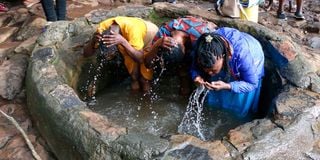Happening Now: DP Gachagua's impeachment motion in Parliament
Team set up to raise Sh25m for Subukia Shrine facelift

Faithful wash their heads at Marian Spring in Subukia on October 5, 2024 after attending the pilgrimage mass.
The pilgrimage site attracts thousands of Catholic Church faithful and other Christians from the country and the region.
The National Marian Shrine in Subukia, Nakuru County, has set out to raise Sh25 million to improve facilities at its holy water spring.
A renowned pilgrimage site for both Catholics and non-Catholics, the project is spearheaded by the Conventual Franciscan Friars, who manage major shrines globally.
The project aimed at restoring and modernising facilities at the spring gained momentum in April after design approvals by the Kenya Conference of Catholic Bishops (KCCB). The designs are currently awaiting approval by the county government.
The shrine draws thousands of pilgrims from Kenya and around the world annually. Last weekend, it played host to thousands of pilgrims from Kenya, South Sudan, Tanzania, Uganda, Malawi and Zambia, among other countries.
Many believe the water from the natural spring at the shrine is holy, capable of bringing blessings, healing and spiritual renewal. Pilgrims also visit for guidance, prayers, and to give thanks. However, the spring area has deteriorated due to natural calamities and human activities.
Planners say the improvements will ensure the shrine is in the same league as the National Shrine of the Immaculate Conception and the National Shrine of Mary, Mother of the Church in the United States, and Basilica of Our Lady of Guadalupe in Mexico City.
Spiritual enrichment
“Beyond restoration, we aim to foster spiritual enrichment, cultural preservation and community engagement,” said Fr Vincent Opuba, Assistant Director of the Subukia National Shrine, on Friday. He added that the rehabilitation aligns with the Catholic Church’s commitment to environmental protection in line with Pope Francis’ message on climate change.
“We must protect our ecosystem because nature never forgives. We must obey nature by planting trees to maintain the water catchment,” Fr Opuba said.
A committee chaired by Justice Alfred Mabeya has been established to raise funds for the project. The other members are Sylvia Karuga (vice-chair), Jerono Talam (secretary), Linus Muigai (assistant secretary) and Nation Media Group Chairman Wilfred Kiboro as a member.
During the site visit, Justice Mabeya stressed the need for significant upgrades to make the spring internationally competitive.
“The current structure at the holy water spring is not befitting a national shrine. There are no sitting facilities and the altar is in a poor state. We want pilgrims to pray in a serene and comfortable environment,” he said. “This is a worthy cause, and I appeal to Kenyans to contribute toward the success of this national shrine.”
To ensure environmental sustainability, the committee plans to plant water-conserving trees like bamboo around the spring.
The engineer in charge of the project, Joseph Waweru Githung’a, explained that the new design would be more open and environmentally friendly.
“The structure will provide proper shelter for pilgrims while maintaining the natural look, with modern touches and aesthetic value,” he said.

Members of the committee in charge of the rehabilitation of the Marian Spring in Subukia, Alfred Mabeya (centre), Eng Joseph Waweru and Dr Wilfred Kiboro (right) on October 4, 2024.
Dr Kiboro highlighted the shrine’s spiritual significance noting that it attracts pilgrims from across the country and beyond.
National shrine
“I have gone to many shrines around the world in Portugal, Rome and Israel and they have been constructed to last for centuries as they attract many people. This being a national shrine, we would like to improve the infrastructure to international standards so that when pilgrims come they pray in a quiet place,” Dr Kiboro said.
He expressed his disappointment at the current state of the facilities.
“There is no reason we in Africa cannot have the kind of shrines we see in other parts of the world. I’m shocked and appalled. The state of the facilities in the spring is pathetic. This is our time to make a difference by building a shrine that is befitting Kenya as a nation and according to international standards. This is not a shrine for Subukia alone. It is a shrine for the whole world,” he said.
The spring’s renovation is already impacting the local economy, with an investor in the hospitality industry constructing a multimillion-shilling hotel near the site.
Separately, KCCB has condemned the political divisions plaguing the Association of Member Episcopal Conferences in Eastern Africa (AMECEA), calling them a “scandal and embarrassment.”
Amecea comprises the episcopal conferences of Ethiopia, Eritrea, Kenya, Malawi, Tanzania, Zambia, Sudan, and Uganda, with Somalia and Djibouti holding observer status.
KCCB Chairman Archbishop Maurice Makumba Muhatia urged Kenyans to pray for political unity across the region.





